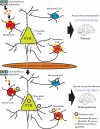Weaving a Net of Neurobiological Mechanisms in Schizophrenia and Unraveling the Underlying Pathophysiology
- PMID: 27113498
- PMCID: PMC5017894
- DOI: 10.1016/j.biopsych.2016.03.1047
Weaving a Net of Neurobiological Mechanisms in Schizophrenia and Unraveling the Underlying Pathophysiology
Abstract
Perineuronal nets (PNNs) are enigmatic structures composed of extracellular matrix molecules that encapsulate the soma, dendrites, and axon segments of neurons in a lattice-like fashion. Although most PNNs condense around parvalbumin-expressing gamma-aminobutyric acidergic interneurons, some glutamatergic pyramidal cells in the brain are also surrounded by PNNs. Experimental findings suggest pivotal roles of PNNs in the regulation of synaptic formation and function. Also, an increasing body of evidence links PNN abnormalities to schizophrenia. The number of PNNs progressively increases during postnatal development until plateauing around the period of late adolescence and early adulthood, which temporally coincides with the age of onset of schizophrenia. Given the established role of PNNs in modulating developmental plasticity, the PNN represents a possible candidate for altering the onset and progression of schizophrenia. Similarly, the reported function of PNNs in regulating the trafficking of glutamate receptors places them in a critical position to modulate synaptic pathology, considered a cardinal feature of schizophrenia. We discuss the physiologic role of PNNs in neural function, synaptic assembly, and plasticity as well as how they interface with circuit/system mechanisms of cognition. An integrated understanding of these neurobiological processes should provide a better basis to elucidate how PNN abnormalities influence brain function and contribute to the pathogenesis of neurodevelopmental disorders such as schizophrenia.
Keywords: Critical period; Neurodevelopment; Parvalbumin interneurons; Perineuronal nets; Schizophrenia; Synaptic plasticity.
Copyright © 2016 Society of Biological Psychiatry. Published by Elsevier Inc. All rights reserved.
Figures

Similar articles
-
Perineuronal nets and schizophrenia: the importance of neuronal coatings.Neurosci Biobehav Rev. 2014 Sep;45:85-99. doi: 10.1016/j.neubiorev.2014.03.018. Epub 2014 Apr 4. Neurosci Biobehav Rev. 2014. PMID: 24709070 Free PMC article. Review.
-
In Sickness and in Health: Perineuronal Nets and Synaptic Plasticity in Psychiatric Disorders.Neural Plast. 2016;2016:9847696. doi: 10.1155/2016/9847696. Epub 2015 Dec 29. Neural Plast. 2016. PMID: 26839720 Free PMC article. Review.
-
Perineuronal Nets: Plasticity, Protection, and Therapeutic Potential.Trends Neurosci. 2019 Jul;42(7):458-470. doi: 10.1016/j.tins.2019.04.003. Epub 2019 Jun 4. Trends Neurosci. 2019. PMID: 31174916 Review.
-
Perineuronal Nets Suppress Plasticity of Excitatory Synapses on CA2 Pyramidal Neurons.J Neurosci. 2016 Jun 8;36(23):6312-20. doi: 10.1523/JNEUROSCI.0245-16.2016. J Neurosci. 2016. PMID: 27277807 Free PMC article.
-
Losing the sugar coating: potential impact of perineuronal net abnormalities on interneurons in schizophrenia.Schizophr Res. 2015 Sep;167(1-3):18-27. doi: 10.1016/j.schres.2014.12.040. Epub 2015 Jan 16. Schizophr Res. 2015. PMID: 25601362 Free PMC article. Review.
Cited by
-
Time in schizophrenia: a link between psychopathology, psychophysics and technology.Transl Psychiatry. 2022 Aug 12;12(1):331. doi: 10.1038/s41398-022-02101-x. Transl Psychiatry. 2022. PMID: 35961974 Free PMC article. Review.
-
Neurointegrity and neurophysiology: astrocyte, glutamate, and carbon monoxide interactions.Med Gas Res. 2019 Jan-Mar;9(1):24-45. doi: 10.4103/2045-9912.254639. Med Gas Res. 2019. PMID: 30950417 Free PMC article. Review.
-
Loss of Interneuron-Derived Collagen XIX Leads to a Reduction in Perineuronal Nets in the Mammalian Telencephalon.ASN Neuro. 2017 Feb;9(1):1759091416689020. doi: 10.1177/1759091416689020. ASN Neuro. 2017. PMID: 28090790 Free PMC article.
-
Neurons derived from different brain regions are inherently different in vitro: a novel multiregional brain-on-a-chip.J Neurophysiol. 2017 Mar 1;117(3):1320-1341. doi: 10.1152/jn.00575.2016. Epub 2016 Dec 28. J Neurophysiol. 2017. PMID: 28031399 Free PMC article.
-
Psychosis spectrum illnesses as disorders of prefrontal critical period plasticity.Neuropsychopharmacology. 2023 Jan;48(1):168-185. doi: 10.1038/s41386-022-01451-w. Epub 2022 Sep 30. Neuropsychopharmacology. 2023. PMID: 36180784 Free PMC article. Review.
References
-
- Weinberger DR. Implications of normal brain development for the pathogenesis of schizophrenia. Arch Gen Psychiatry. 1987;44:660–669. - PubMed
-
- Keshavan MS, Giedd J, Lau JY, Lewis DA, Paus T. Changes in the adolescent brain and the pathophysiology of psychotic disorders. Lancet Psychiatry. 2014;1:549–558. - PubMed
-
- Bakhshi K, Chance SA. The neuropathology of schizophrenia: A selective review of past studies and emerging themes in brain structure and cytoarchitecture. Neuroscience. 2015;303:82–102. - PubMed
-
- Iyegbe C, Campbell D, Butler A, Ajnakina O, Sham P. The emerging molecular architecture of schizophrenia, polygenic risk scores and the clinical implications for GxE research. Soc Psychiatry Psychiatr Epidemiol. 2014;49:169–182. - PubMed
Publication types
MeSH terms
Substances
Grants and funding
LinkOut - more resources
Full Text Sources
Other Literature Sources
Medical

